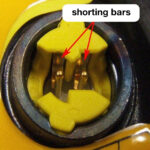Airbag System
Contents
hide
Overview
Nomenclature
- Unit = Module = Computer = ECU
- Airbag Computer = SRS = ORC = RCM = MRS
- Passenger Occupancy Detection System = OCS = OPDS = ODS = SWS
Motion Sensitivity
- Newer SRS units usually have built-in longitudinal and latitudinal acceleration sensors.
- They are usually responsible for deploying the roof airbags.
- If the SRS system is energized while motion sensitive components are triggered, a simple jerky movement of the impact sensor or the SRS module is designed to deploy airbags.
- Quite a few people told me that they never had a problem by working on the SRS system without disconnecting the battery (even with ignition turned on), until one time they got roof airbag blown at their head.
- SRS unit along with impact sensors constitute a part of the airbag system that senses motion.
- Based on that input SRS unit decides if the collision is strong enough to deploy airbags, and which airbags to deploy. If the dashboard airbag needs to be deployed, SRS unit checks the occupancy of the passenger front seat (with installed Occupancy Detection System).
- ⚠️ When working with the SRS system components, always de-energize the airbag system by disconnecting the battery for a few minutes.
Airbags | Pretensioners
-
Speed of deployment
- The air bag deploys at 200-300 mph, depending on the manufacture.
- From the time of impact to the time of full airbag deployment is from 21 to 27 milli-seconds (a fuse, in comparison, burns in 10-28 milliseconds).
-
Shorting Bars
- Shorting bars are a safety device that connects or shorts the airbag terminals together when the connector is separated. It’s employed to prevent an open harness connection from being shorted to voltage and ground accidentally deploying the airbag. When testing an airbag or a seatbelt pretensioner, it important to unshorten them (e.g. with a tooth pick).

Interlinking with Other Systems
-
ABS | Traction System
- Might use acceleration sensors from the SRS unit
-
Alarm System
-
ECM | BCM | Hybrid ECU
- RCM might send a ‘Crash Signal‘ to prevent the engine from running (e.g. [GM, Land Rover, Volvo, Toyota, Lexus, Subaru, Mercedes])
Crash Data
- When powered up, SRS unit constantly monitors and stores relevant data that might be needed for a post-crash investigation. This data is called the crash data.
- It includes:
- Vehicle speed
- Brake light switch (On/Off)
- Engine speed
- Throttle position
- It may also record:
- Impact speed change or ∆V
- Seat belt use
- Airbag deployments
- Seat belt pre-tensioner deployments
- It includes:
-
Hard Code vs Soft Code
- Depending on a car, on how many accidents it had, and what airbags has been deployed, crash data is stored as either a soft code that can be reset be a scanner through OBDII or as a hard code that will require manual on-the-bench reprograming/re-flashing of the SRS unit.
- OBDII crash data reset (soft-code) might work on these
- Most BMWs
- Most Mercedeses
- Most Audis/ VWs (mostly 2005-)
- Most Volvos
- Most of 2010- GM
- Some Fords and Mazda
- Most Chrysler, Dodge, Jeep
- Some old Toyotas
-
Common Crash Codes
- B1000 – SDM Malfunction
- B1000/31 – Center Airbag Sensor Assembly Malfunction
- B1034 – Crash zone sensor has malfunctioned
- B1035 – Crash zone sensor communication error
- B1193 – Crash Event Storage
- B1209/B1210 – Frontal/Side collision detection
- B1231 – Event Threshold Exceeded
- B1239 – Air bag diagnosis sensor unit is malfunctioning
- B1499 – SRS-ECU air bag condition monitor detects deployed air bag
- B1620/B1670 – Supplemental restraint system control module internal fault (replace SRSCM)
- 65535 – Internal control module memory error-intermittent
- 5-1 |8-5 | 9-1 – Internal Failure of the SRS unit
-
SRS light is ON after the accident, but no airbags were deployed?
- Frequently you might not see any airbags deployed, or seatbelts locked, but seatbelts (chemical charge) might still be deployed internally and computer will store a code. Sometimes computer doesn’t store a code (e.g. some Toyota, Honda …) but it still has crash memory that needs to be cleared.
- Sometimes you will not have any airbags deployed, but computer will register a crash event, or set a code for passenger seat weight sensor re-calibration.
-
Crash Data vs Hardware Failure
- Sometimes, after an accident, besides crash data stored, airbag modules receive internal hardware damage.
- Failure rates depend on car’s make and model. For example:
- 2012-2014 Civic, Fit have up to 20% of HW failure rate.
- 2010-2013 Mazda3 has up to 20-40% of HW failure rate due to failing IC Drivers such Bosch 40063, 40064…
Occupancy Detection System
-
What is occupancy mat?
- The front passenger seat occupant detection mat determines if and how the passenger frontal air bag should deploy in a crash. In the case of a frontal collision, if impact is severe enough to cause driver airbag to deploy, airbag module will check the passenger occupancy mat status to determine whether passenger airbag should deploy also or not. If no one is sitting on a passenger seat, or if there is a small weight object like a car seat, front passenger airbag will NOT deploy. Often, due to age, occupancy sensors/mats go bad, giving Faulty passenger occupancy sensor/mat trouble code in the airbag module.
-
⚠️ Occupancy Mat Disablement Implications
- It’s also worth noticing that many cars worldwide don’t offer occupancy detection system by default, so for many countries its an optional equipment.
- Disabling the mat will make front passenger airbag DEPLOY in frontal crash REGARDLESS of whether passenger seat is occupied or not. Needless to say, whether you have occupancy detection system or not, you should never place car seats with children on the front seat; front airbag deployment can kill them.
General Troubleshooting Notes
Testing Airbags, Seatbelts, Buckle Pretensioners
-
Good Ohmmeter
- If the resistance is lower than 2 Ω, you didn’t disengage shorting bars.
- If it reads more than 7Ω (given you have connected good test leads to the two airbag pins correctly), 99.9% the airbag is faulty and needs replacement.
- Use an extra airbag connector to plug into airbag for testing or take a tooth pick and wedge it between airbag pins and shorting bars to unshorten them.
- Measure the resistance across the airbag pins.
- Airbag resistance is usually between 2-3 Ω. Rarely can be as high as 7 Ω.
-
Scanner + Bypass Resistor
- If the airbag codes clears, then inspect the plug, especially the part that unshortens shorting bars (read description above).
- If that looks good, suspect failed airbag/seatbelt.
- Use 2.2 Ω 1/8W resistor to bypass the suspected airbag and try to clear the trouble code.
- If trouble code doesn’t clear, suspect wiring or in SRS unit.
Impact Sensor Testing
-
Swap
- Impact sensors that can be swapped are usually located symmetrically lengthwise on a car’s body. Meaning,
- Front left & right sensors are interchangeable (at least for testing purposes)
- Side left & right sensors are interchangeable
- Rear left & right sensors are interchangeable
- Front, side, and rear sensors are NOT interchangeable. So, you cannot put left front sensor to test left side sensor.
- So, if you have a code about possibly bad front left impact sensor, you can swap it with a front right one and check a code again. If code now complains about right side sensor
- Don’t forget to disconnect the battery before swapping them.
-
Check Wiring
- Note, sensor wires polarity makes a difference.
- When testing for power between sensor wires, note that power can be supplied to a sensor by SRS module only for a brief period of time after ignition is switched on, so you would have to have MIN/MAX button on your multimeter to catch that brief moment.
SRS Light is On
-
After accident?
- If there is a crash code, or the SRS light is on without any codes, most likely SRS module needs crash data removed.
- Learn More
-
No codes, no accident?
- Check Alternator
- Bad alternator can oversupply power to all electronic devices (e.g. 01′-05′ Civic)
Misc
- Airbag Stages (for replacement reference)
|
Part Number 09082-30801 |
 |
 |


